PATH: Boat Building & Refitting » Boat Equipment » Propulsion » Engines »
PAGE CONTENTS: (click ⇒ to go to each section on this page)
⇒ Topic Treatment: Introduction, Overview, Background, Details, Directories,+.
⇒ ^ Related Resources: EAB Topics w/Directories, Vendors, Products: Media: Books, Websites,+.
⇒ Visit EAB's FEATURED ARTICLES Home Page to preview the vast scope of our website.
⇒ This Month's Top 20 Most Popular Articles on our EAB website.
⇒ Layout of the EverythingAboutBoats.org Website's Pages: Page Types, Contents, Topics,+.
⇒ What our nonprofit Anchors Aweigh Academy and its EAB website have accomplished.
⇒ Members must SIGN IN to gain access to Members Only areas of this website.
⇒ Become an Academy Member and gain access to additional pages and programs!
⇒ Comments: Submit To ⇒ Comments♥EverythingAboutBoats.org (Replace "♥" with "@").
ROUGH DRAFT
Opposed Pistons (outward facing with one crankshaft) (Flat, Boxer,+)
“V” Pattern Engines: V6, V8, V12, V16, V24, etc. “W” Pattern Engines
The weak “bottom-end” is a consequence of the “V” cylinder configuration where the crankshaft is so short that the room available for the “bottom end” bearings e.g. the crankshaft main bearings and the connecting rod journal bearings, is so narrow that the bearings lack enough width to carry the load at RPM.
This weakness, however is common of most smaller “V” cylinder configuration engines, especially those with cylinder bores less then 5 inches (127mm) and is due to the overall shortness of the crankshaft.
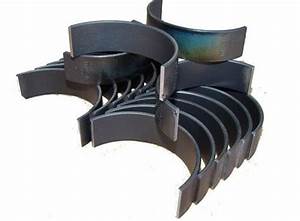
V8 Rod Bearings
Compare the width of the small V8 connecting rod bearings above with the width of the inline-4 bearings below which are nearly twice as wide.

Inline 4 Rod Bearings
With twice as many pistons connected to a V8 crankshaft which is typically only slightly longer then an inline 4-cylinder crankshaft, there just isn’t much room for the connecting rod bearings, the crankshaft main bearings, and the crank webs. Consequently the V8’s bearings and webs must be much narrower as graphically shown in the pictures above and below.
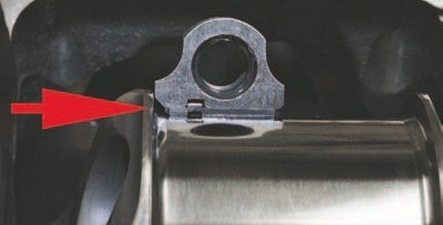
Unfortunately, in the case of any slipping type bearings such as crankshaft bearings, the narrower the bearings, the more difficult it is maintain an adequate lubricating oil film between the bearing’s surface and the crankshaft to support the heavy loads of a high compression diesel engine especially under load at higher RPM’s.

Detroit Diesel 8.2 Crankshaft
Even though the connecting rod pins on a V8 crank are the widest journals on the crank, when assembled the V8 crank will have two connecting rods crowded onto each rod journal leaving little room for each individual rod bearing.
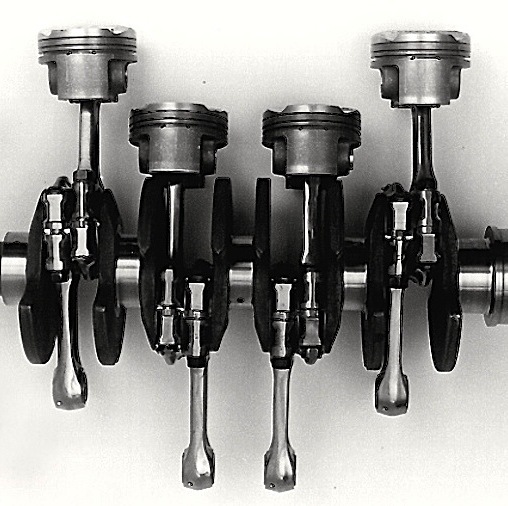
V8 Crankshaft with Two Rods assembled to each rod Journal.
In the pictures above and the illustration below, it is easy to see how narrow the rod bearings have to be. Note the two oil feed holes per rod journal (one for each connecting rod. In a fully pressurized lubrication system, the oil is fed to the center of each bearing so that it can form an oil film between the crankshaft journal and the bearing surfaces, as it works its way to the outer edges of the bearing where it squirts out and splatters around the crankcase as the crankshaft turns. Oil tends to exit narrow bearings much more quickly. The wider the bearings, the more oil between the bearing and crankshaft surfaces to carry the load and the more slowly the oil is forced out from between the metal surfaces of the crankshaft and bearings, hence wide bearings can carry higher loads. The larger the cylinder bores, the longer the crankshaft and therefore the more room available for wider bearings. V8 engines with cylinder bores larger then 6″ typically have plenty of room on the longer crankshaft for wide bearings, etc.
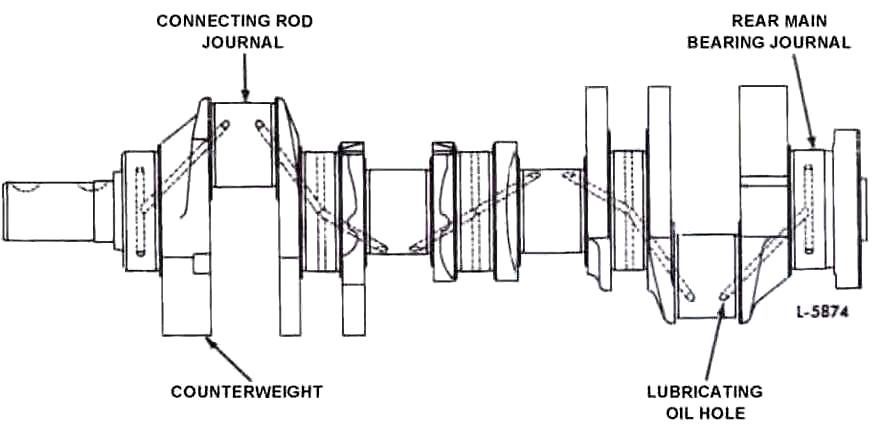
Detroit Diesel 8.2 Crankshaft – Illustration.
Note how narrow the five main bearing journals are especially when compared with the 4-cylinder crankshaft second below. Main bearings will be discussed in more detail a little later.
Another issue with any small V8 crankshaft is the narrow crank webs which are much weaker and consequently much more prone to breakage as shown below.

V8 Crankshaft with broken web near front end of crankshaft (left).
By comparison, the inline 4-cylinder crankshaft directly below which will have only one rod fitted per journal when assembled can have much wider rod bearings. And note the much wider main bearing journals which will accommodate much wider main bearings. Also note the wider and much stronger crank webs between the bearing journals.

Detroit Diesel 4-53 4-cylinder 2-stroke cycle crankshaft.
The inline 4-cylinder crankshaft shown above has 5 main bearings. The crank webs, and the width and diameter of the main and rod bearings have been optimized to carry the stress and load of a high compression, high output engine. By comparison, the V8 crankshaft has the same number of main bearings for twice as many cylinders, and the V8 main bearing journals are much narrower. You can see how crowded a small V8 crankcase can be in the picture directly below. There just isn’t enough room for rod bearings or main bearings to be wide enough to carry the heavy loads generated by a high compression high output engine.
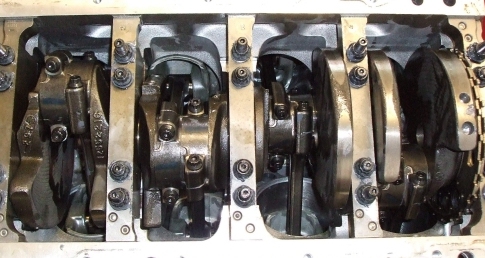
Notice that the main bearing journals of the V8 crankshafts shown in the illustration and pictures above have been increased in diameter to increase the bearing surface in an effort to compensate for their narrowness. But at some point this becomes counter-productive because the increased diameter increases the slip-bearing surface speed which makes it more difficult for the oil to maintain adequate oil film thickness at higher RPM’s. By comparison, a 4-cylinder crank’s main bearings can be wider so they can more easily maintain oil film thickness and carry the loads, hence the journals can be smaller in diameter to reduce bearing surface speed. This is why inline engines with the wider bearings and stronger crank webs, and main bearings between each cylinder can be air charged (e.g. with a turbocharger) to reliably produce more than twice the horsepower per unit of displacement then a small V8. Air-charging these stronger inline diesel engines can also enable them to run cleaner with fewer emissions. This benefit is discussed in detail in our article titled Fuel Fundamentals.
Engines with longer piston strokes have the advantage of typically producing much higher torque at slower crankshaft speeds (RPMs). Many small V8 engines are designed with a stroke much shorter then most other diesel engines of this displacement. It is just slightly “under-square” with a 108mm bore x 112mm stroke. Besides allowing the engine height to be lower, the shorter stroke also has the advantage of reducing the load on the “bottom end”. Unfortunately, any of these short stroke, nearly-square and over-square engines produce less torque and have to be set-up to run at higher RPM’s to produce their maximum power, which is limited by their increased crankshaft slip-bearing surface speeds. Unfortunately, as bearing surface speed increases, bearing wear increases and so does the risk of bearing failure.
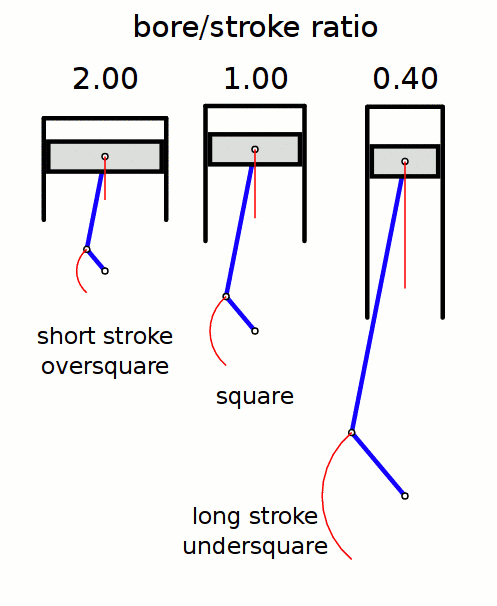
In conclusion
The above comparisons show why smaller V8 engines that lack the space for the wider crankshaft bearings and stronger crank webs are not capable of the higher power outputs of comparable displacement inline engines. These are some of the main reasons why most diesel engine manufacturers have abandoned building small V8 engines and have embraced inline configurations especially the turbocharged 6 cylinder inline with 7 main bearings such as the Cummins B and C series engines. In the case of V8 engines with bores larger than 5 inches (127mm), they are longer and therefore have more room for wider crankshaft bearings and stronger crank webs which means that they can have much stronger “bottom ends” and therefore higher power outputs per displacement unit then their smaller, shorter, and weaker little brothers.
+
In V8 engines, two connecting rods often ride on the same crankshaft connecting rod journal (or pin). This can be seen in the picture of a GM V8 below. For illustrative purposes, not all the rods have been installed. The far left journal has two rods (#1 & #2) attached (#1 is clearly visible), the next journal to the right has one rod attached (#3), and the next two journals to the right have no rods attached. The connecting rod bearing oil feed holes are clearly visible in the far right (#7 & #8) rod journal. The very narrow main bearing caps are also clearly visible. This engine has two bolts fastening the main bearing caps to the block. High output V8 engines often have “four bolt mains” to increase the strength of the main bearing cap.
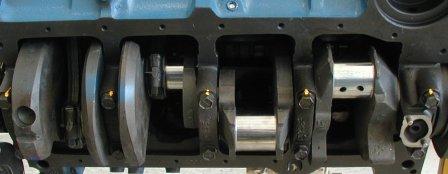
Bottom End – GM 350 Small Block Chevy V8
In smaller “V” engines with very short crankshafts as above and the Detroit Diesel 8.2 Litre V8 engine, there is very little room for the crankshaft main bearings, the crankshaft counterweights and the connecting rod bearings, so the bearings tend to be too narrow for the load. The Detroit Diesel 8.2 is air charged (turbocharged) to only 149 kW or 200 horsepower for marine service simply because there is not enough room for wide enough bearings to handle the heavier loads from more horsepower and torque. Thus the 8.2 is rated at less then 0.3 kW or 0.4 horsepower per cubic inch of displacement. “V” engines larger then 2 liter per cylinder usually have enough room for bearings wide enough to carry the loads. Inline engines of all sizes have plenty of room for more then adequate bearings. That’s why inline diesel engines can be air charged (eg turbocharged and intercooled) enough to exceed one horsepower per cubic inch of displacement and still be duty rated for very heavy service.
+.
NOTE: Not all 4-cylinder inline engines have 5 main bearings supporting the crankshaft. Some light duty 4-cylinder inline engines have only 3 main bearings (as illustrated below) and therefore can not produce as much power output as comparable 4-cylinder inline engines with 5 main bearings. Likewise, some light duty 6-cylinder inline engines have only 4 main bearings instead of 7, and some inline 8-cylinder (straight-eight) engines have only 5 main bearings instead of 9, etc.
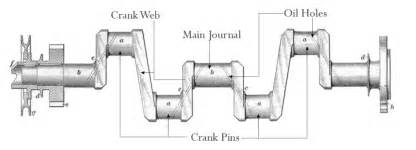
NOTE: The ultra-light duty 4-cylinder inline Atomic-4 gasoline engine has only 2 main bearings. One on each end of the crankshaft as shown below. Instead of a middle main bearing journal between the #2 and #3 rod journals, there is simply a counterweight to reduce flexing and vibration. Note the width of the main bearing and rod bearing journals on the Atomic-4 crankshaft below compared to the much narrower ones on the small V8 crankshafts shown farther above.

Atomic-4 Crankshaft
NOTE: Surprisingly, some small V8 engines have fewer than 5 main bearings. For example, the popular ultra-light duty Ford “flat-head” V8 gasoline engines of the 1930’s, 40’s & early 50’s had only 3 main bearings. One bearing on each end of the crankshaft and one in the middle as shown below. Strangely, this provides somewhat of an advantage. By having two fewer main bearings, additional space is available for the three remaining main bearings allowing them to be slightly wider. The crank webs were also thicker and stronger. Still, the Ford “flat-head” V8 engine is universally recognized as having a fairly weak “bottom end” primarily due to having only 3 main main bearings, with their rather weak “two bolt” main bearing caps, and of course because of the two connecting rods with narrow bearings being attached to each rod journal like most small V8’s. Fortunately, in it’s stock configuration, there is little load on this engine’s “bottom end” due to it’s small bore, short stroke, low compression ratio, and low power output. But, when modified for high performance racing, the “bottom end” weaknesses begin to express themselves in rapid bearing wear, spun bearings, thrown rods, and broken cranks.

Ford “Flat-Head” V8 Gasoline Engine “Bottom End”.
How To Keep The 8.2 Alive
Because of these recognized inherent weaknesses, Detroit Diesel never did set up the 8.2 engines to produce very high power outputs (see Engine Spec Table later in this article). Fortunately, in a vehicular application, the engine is rarely operated at higher power output for very long, usually just during acceleration and when climbing hills. If the 8.2 engine is intentionally operated at reduced power (below 80%), by shifting down and easing up on the throttle, doing so has proven to help it survive. In a marine application this is accomplished by under-pitching the propeller, avoiding any rapid acceleration, and if necessary, reducing the vessel’s cruising speed. Unfortunately, this often encourages excessive carbon buildup and its ensuing problems, including “injector misfire“. Since the practice of routinely running at full throttle (flank speed) to blow out the carbon soot is NOT recommended with the 8.2, because doing so often results in head gasket failure or catastrophic bearing failure, other ways of reducing carbon buildup must be utilized. Unfortunately, the benefits of “water injection” are limited because the 8.2 should not be run at full throttle when most of the soot would be blown out. But adding certain carbon reducing (and injector cleaning) fuel additives can be quite helpful.
+
Uneven-Firing V6 (-putt-putt—putt-putt—putt-putt-) engines like the Buick Special (225 cubic inch) became popular in boats in the 1960’s when marinized by OMC and branded as “OMC”, “Johnson” and “Evenrude”). The crankshaft was similar to a V8 crankshaft in as much as two connecting rods were fitted side-by-side on each extra-wide rod journal. The rod journals were of course set 120° apart instead of the 90° piston phasing in the case of the V8 crankshaft. This V6 “Bottom End” inherited the same weaknesses as the “Bottom Ends” of the small V8 engines described above due to its short crankshaft that lacked enough room for crankshaft webs and bearings.

Even-firing V6 engines tend to have the weakest “Bottom Ends” of all due to the 30° off-set (or “staggered”) rod journals that leave even less width for the crankshaft webs and bearings. Most modern V6 engines are of the even-firing design.
 Note how narrow and weak the crankshaft webs are between the adjoining connecting rod journals.
Note how narrow and weak the crankshaft webs are between the adjoining connecting rod journals.
+
Straight (Inline) engine from Wikipedia
Inline engine (aeronautics) from Wikipedia
Crossplane from Wikipedia
V6 engine from Wikipedia
V8 engine from Wikipedia
W engine from Wikipedia
+
Related Media
with Links to EAB's Media Overview and Creator Profile Pages
Media with Bold Titles are part of our Academy eLibrary!
Academy Members can view the Media by clicking on its Bold Title Link to go to its
EAB overview page and then scrolling down to the "Academy eLibrary" section for its link.
To help us alphabetize the media lists below, each leading grammatical
article ("The" - "A" - "An") has been moved to the end of the title.
DS = Data Source code
⇒ Media Directory Under Development ⇐
| MEDIA TYPE: | RC |
| Title — Creators (Authors‚ Editors‚ Illustrators‚+) – Source (Publishers‚+) | RC |
| Product Documentation: | D |
| ΞTitleΞ – + (ΞNotesΞ) — ΞCreatorΞ – ΞSourceΞ | D |
| Books: | B |
| ΞTitleΞ – + (ΞNotesΞ) — ΞCreatorΞ – ΞSourceΞ | B |
| Magazines: | M |
| ΞTitleΞ – + (ΞNotesΞ) — ΞCreatorΞ – ΞSourceΞ | M |
| Videos: (Incl. Movies‚+) | V |
| ΞTitleΞ – + (ΞNotesΞ) — ΞCreatorΞ – ΞSourceΞ | V |
| Websites: | W |
| ΞTitleΞ – + (ΞNotesΞ) — ΞCreatorΞ – ΞSourceΞ | W |
If any Media or Creators should be added to this list, please submit their info/links via email To:
Editor♥EverythingAboutBoats.org (Replace "♥" with "@")
NOT AN ACADEMY MEMBER?
CLICK HERE to discover how you can become a Member and gain FULL access to
thousands of expanded pages and dozens of excellent programs including our eLibrary!
CLICK HERE to view ALL the books, magazines, videos, etc. in our Academy eLibrary.
Media are also listed by category on the Topic Pages found on the Right Sidebar ⇒
CLICK HERE to donate any books, magazines, manuals, or videos, etc. to our Library.
- +
- +
02 – BOAT BUILDING, OUTFITTING, REFITTING & REPAIR: (Incl. DIY).
02.01 – Boat Designing Schools:
02.02 – Boat Designers: (Naval Architects, Boat Plans, Kits,+).
02.03 – Statutes & Standards: (Vessel & Equipment Requirements,+).
02.03.01 – Marine Laws & Regulations: (CAN, GBR, USA,+).
02.03.02 – Industry Standards: (ISO, IMO, ABYC, NFPA,+).
02.03.03 – Classification Societies: (ABS, LR, DNV<GL, BV, RINA,+).
02.04 – Boat Building & Refitting Tools,+: (Vendors, Specs, Manuals, Recalls,+).
02.05 – Boat Materials: (Qualities, Vendors, Specs, Manuals, Recalls,+).
02.05.01 – Wood: (Species, Rot; Carvel, Clinker/Lapstrake, Veneer/Plywood, Cold Molded,+).
02.05.02 – Metal: Iron, Steel, Aluminum, Copper,+. (Strengths, Weaknesses, Corrosion,+).
02.05.03 – Ferrocement: (Strengths, Weaknesses, Corrosion,+).
02.05.04 – FRP & GRP Composites: Fiberglass, Carbon Fiber,+. (Strengths, Weaknesses,+).
02.06 – Boat Equipment: (Vendors, Specs, Manuals, Reviews, Recalls,+).
02.06.01 – Steering & Thrusters: (Mechanical, Electric, Hydraulic,+).
02.06.02 – Stabilizers & Trim Plates: (Mechanical, Electric, Hydraulic,+).
02.06.03 – Dewatering Devices: (Bailers, Bilge Pumps,+).
02.06.04 – Galvanic Corrosion Protection: (Active, Anodes,+).
02.06.05 – Hull Penetrations & Openings: (Thru-Hulls, Scuttles, Skylights, Hatches,+).
02.06.06 – Deck Hardware & Equipment: (Cleats, Railings,+).
02.06.06.01 – Ground Tackle: (Anchors, Rodes, Chocks, Winches,+).
02.06.06.02 – Commercial Fishing Gear: (Pots, Nets, Lines, Winches, Reels, Rods,+).
02.06.07 – Rigging: (Rig Types, Standing Rigging, Running Rigging, Vendors, Riggers,+).
02.06.07.01 – Sails: (Sail Types, Aerodynamics, Vendors, Sailmakers,+).
02.06.08 – Propulsion Machinery: (Types, Configurations, Features, Control Systems,+).
02.06.08.01 – Engines: (Systems, Manufacturers, Marinizers, Resellers,+).
02.06.08.01.01 – Engine Mechanical (Pistons, Rods, Crankshafts, Cylinders, Heads, Valves,+).
02.06.08.01.02 – Engine Lubrication (Splash, Forced, Oil, Filtration, Additives, Oil Analysis,+).
02.06.08.01.03 – Engine Aspiration & Fuel (Natural & Charged; Gasoline, Diesel, Bunker, NG,+).
02.06.08.01.04 – Engine Electrical (Cranking, Charging, Ignition, Instrumentation, Electronics,+).
02.06.08.01.05 – Engine Cooling (Air, Liquid: Raw Water, Fresh Water w/Keel Coolers, Heat Exchangers,+).
02.06.08.01.06 – Engine Exhaust (Dry, Wet w/Separators,+).
02.06.08.01.07 – Engine Mounting (Hard, Soft,+).
02.06.08.02 – Engine-to-Marine Gear Interfaces: (SAE Specs, Damper Plates, Jackshafts,+).
02.06.08.03 – Marine Gears: (Reversing, Reduction; Mechanical, Hydraulic).
02.06.08.04 – Shafting: (Propshafts, Couplings, Seals, Bearings, Struts, Keys, Nuts,+).
02.06.08.05 – Propellers: (Types, Materials,+).
02.06.09 – Electrical Systems: DC & AC (Direct Current: Batteries, Solar,+; Alternating Current,+).
02.06.09.01 – Auxiliary Generators: (Diesel, Gasoline, Natural Gas,+).
02.06.09.02 – DC-to-AC Inverters:
02.06.10 – Navigation & Communication Systems: (Charting, GPS. Radar; WX, SAT, HF, VHF,+)
02.06.11 – Safety Equipment: (Life Rafts, PFDs, Firefighting Eq., Alarms, Medical Kits,+).
02.06.12 – Domestic Systems:
02.06.12.01 – LPG & CNG Systems:
02.06.12.02 – Cabin Heating & Cooling: (Heaters, Heat Pumps; Air Conditioning,+)
02.06.12.03 – Galley Appliances: (Refrigeration, Galley Stoves,+).
02.06.12.04 – Water & Waste Systems: (Tanks, Water Makers, Pumps, Plumbing,+)
02.06.12.05 – Trash Disposal:
02.06.12.06 – Furnishings: (Cabinetry, furniture, Coverings, Entertainment, Weather,+).
02.06.13 – Personal Equipment:
02.06.13.01 – Diving: (Commercial & Sport).
02.06.13.02 – Fishing: (Sport).
02.06.13.03 – Racing: (Sail, Offshore Power, Powerboat, Hydroplane,+).
02.06.13.04 – Sailing: (Foul Weather Gear, Safety Harnesses,+).
02.06.13.05 – Watersports: (Surfing, Skiing, Boarding, Tubing,+).
02.06.14 – Boat Tenders:
02.06.15 – Boat Trailers: (Bunk, Roller,+)
02.07 – Marine Suppliers: (CAN, GBR, USA,+). (National Chains, Local,+)
02.08 – Boat Builders: (A∼Z) (w/Vessel Types, Locale & Years Active)
02.09 – Boat Refitters: (CAN, GBR, USA,+) (Shipyards, Boatyards, Riggers, Repair Shops,+).
02.10 – Boat Building, Outfitting, Refitting & Repair Schools: (Incl. DIY).
02.11 – DIY Boat Building, Outfitting, Refitting & Repair: (Maintenance‚ Troubleshooting‚+).
15 – DO-IT-YOURSELF (DIY):
15.01 – DIY Boat Building, Outfitting, Refitting & Repair: (Incl. Maintenance & Fault Finding).
15.02 – DIY Boat Sales: (Buyers & Sellers).
15.03 – DIY Boat Inspections: (Pre-Survey, Pre-Purchase, Pre-Sale, Pre-Voyage, Sea Trials,+).
15.04 – DIY Schools & Classes: (Boat Building, Refitting, Inspection, Troubleshooting, Repair,+).
16 – MEDIA w/Creator Directory: (Authors, Editors, Publishers,+) + Academy eLibrary.
16.01 – Documentation: (Catalogs, Ads, SpecSheets, Manuals, TechVids, Bulletins, Recalls‚+).
16.02 – Books: (Bound, eBooks,+).
16.03 – Magazines: (Incl. Back Issues, Articles,+).
16.04 – Videos: (How-to-Tutorials, Documentaries, Travelogues, Movies,+).
16.05 – Websites: (Incl. Articles, Forum Posts, Tech Tips, Tech Notes, Social Media,+).
+
EVERYTHING ON THIS PAGE OK?
If there is anything on this webpage that needs fixing, please let us know via email To:
Editor♥EverythingAboutBoats.org (Replace "♥" with "@")
THIS ARTICLE IS STILL EVOLVING!
The page may contain rough drafts that include raw source materials.

Visit our FEATURED ARTICLES Home Page
to see examples of our website's comprehensive contents!
Thanks to our amazing contributors for the steady flow of articles, and to our dedicated all-volunteer staff who sort, polish and format them, everyday we get a little bit closer to our goal of
Everything About Boats. If you would like to submit an article,
See Submitting Articles.
— TOP 20 MOST POPULAR ARTICLES —
Detroit Diesel 8.2 Liter “Fuel Pincher” V8 Engine
Cummins V-555 & VT-555 “Triple-Nickel” V8 Diesel Engine
Lehman 120 (6D380) Diesel Engine (Ford 2704C & 2715E)
Ford Industrial Power Products Diesel Engines
How to Identify Ford Diesel Engines
Ford 2715E Diesel Engine
Lehman Mfg. Co.
Perkins Engines
Universal Atomic 4
Sears Boat Motors: Motorgo, Waterwitch, Elgin, etc.
Chrysler & Force Outboards
Eska Outboard Motors
Allison Transmission
ZF Friedrichshafen AG
Marine Surveyors by Country
American Marine Ltd (Grand Banks)
Boat Inspection (Types of Marine Surveys)
Boat Builders: (A∼Z) (w/Vessel Types, Locale & Years Active)
USCG NVIC 07-95 Guidance on Inspection, Repair and Maintenance of Wooden Hulls
American Boat and Yacht Counsel (ABYC)
Layout of the EverythingAboutBoats.org Website's Pages
— Types of Webpages —
This website consists almost entirely of 3 types of webpages as follows:
- TOPIC PAGES (See Main Topic Pages listed on Website Contents or the Right Sidebar) ⇒
- EXAMPLE: – WEBSITE CONTENTS w/Links to MAIN TOPIC & Subtopic Pages:
- EXAMPLE: 02 – BOAT BUILDING, OUTFITTING, REFITTING & REPAIR:
- EXAMPLE: 02.06 – Boat Equipment:
- EXAMPLE: 02.06.08 – Propulsion Machinery:
- EXAMPLE: 02.06.08.01 – Engines w/Directory of Vendors.
- VENDOR PAGES (Vendors of Products, Services, Events,+, Destinations & Media Creators)
- EXAMPLE: 02.06.08.01 – ^ Ford Industrial Power Products Diesel Engines.
- PRODUCT PAGES (Equipment, Events, Media: pDoc, Books, Magazines, Videos, Websites,+)
- EXAMPLE: 02.06.08.01 – ^ ^ Ford 2715E Diesel Engine.
- EXAMPLE: 02.06.08.01 – ^ ^ Ford OpManual - 2710 Range Diesel Engines.
- EXAMPLE: 02.06.08.01 – ^ ^ Ford Service Manual - 2700 & 2710 Range Diesel Engines.
Clickable Links that lead to other webpages appear in Blue Text and usually open in a new window.
Links in the Right Sidebar and most directories open in the current window, not a new window.
Note in the examples above that these pages form a natural hierarchy.
The unnumbered "^" pages are listed alphabetically in most tables.
Media Titles in tables are distinguished by their smaller font size.
Media (Books, Magazines, Videos, Articles,+) are treated as Products.
Vendors' Product Documentation (pDoc) are considered Media.
Destinations & Media Creators are treated as Vendors.
All Website Pages are optimized for viewing on
full-width disktop computer monitors,
but can be viewed on phones.
— Contents of Webpages —
Website Pages typically contain the following Sections:
- PATH (Shows the chain of EAB pages w/links that lead to the page being viewed).
- EXAMPLE:
PATH: HOME, WEBSITE INDEX, WEBSITE CONTENTS » ∨
∧ BOAT BUILDING & REPAIR » Boat Equipment » Propulsion » Engines » ∨∨
∧∧ Ford, Ebro, American Diesel, AmMarine, Barr, Beta, Bomac, Bowman, Couach,
Lees, Lehman, Mermaid, Parsons, Renault, Sabre, Thornycroft, Wortham Blake »
∧ DO-IT-YOURSELF » DIY Boat Building & Repair » DIY Schools & Classes »
∧ MEDIA w/Creator Directory » Documentation, Books, Magazines, Videos, Websites » - (The "»" right pointing Guillemet symbol shows the chain through the page links.)
- (The "," comma between page links in the chain indicates pages are not subordinate, but are instead at the same level. See engine brands in the example above.)
- (The "∨", "∨∨", "∨∨∨",+ symbols indicate that the path line continues with whatever follows the "∧", "∧∧", "∧∧∧",+ symbols respectively. "∧" Precedes each MAIN TOPIC Page.)
- EXAMPLE:
- PAGE CONTENTS (Table of Contents with links to each main section on the page).
- PAGE BODY (The type of page determines the contents of its body as follows:).
- TOPIC PAGES (Topic Treatment: Introduction, Overview, Background, Details,+).
- (Many Topic Pages contain Directories of Vendors with Links).
- (Most Directory Listings are Alphabetical and/or by Locale).
- VENDOR PAGES (Vendor's Profile, Contact Information, Products, Services,+).
- (Manufacturers, Resellers, Refitters, Yards, Surveyors, Clubs, Schools, Authors,+).
- (Boating & Travel Destinations are treated as Vendors on their own Vendor Pages).
- PRODUCT PAGES (Product Features, Vendor Links, Specifications, Documentation,+).
- (Media created by a vendor is often treated as a Product on its own Product Page).
- (Boating & Travel Events are often treated as Products on their own Product Pages).
- TOPIC PAGES (Topic Treatment: Introduction, Overview, Background, Details,+).
- RELATED RESOURCES (Topics, Vendors, Products, Media: Books, Websites,+ with Links).
- PAGE TAIL Contains the following Anchors Aweigh Academy & EAB Website Features:
- The Anchors Aweigh Academy's EverythingAboutBoats.org Header.
- A link to our Featured Articles EAB Home Page.
- Top 20 Most Popular Articles. (The section that appears right above ⇑ this section).
- Layout of the EverythingAboutBoats.org Website's Pages. (This very section ⇐).
- Topics of Webpages. (The very next section below ⇓).
- What we have accomplished so far.
- Members must Sign-In to gain full access to Expanded Pages & Programs.
- Sign-Up (if not already a member).
- Public Comments (about the website & about this page).
- RIGHT SIDEBAR (Website Contents menu with links to Main Topic & Subtopic pages).
(On some smart phones, the Right Sidebar may appear at the bottom of the webpage)
— Topics of Webpages —
Website Pages are categorized under the following 16 MAIN TOPICS:
The MAIN TOPICS follow a natural progression from conception of the vessel thru its
building, marketing, survey, financing, insuring, transport, moorage, use and upkeep.
The MAIN TOPICS (all Caps) below are followed by their Main Subtopics with Links.
00 – HOME: CONTENTS, ABOUT EAB: Contact EAB, Abbreviations & Symbols, FAQ, GLOSSARY, ADs,+.
01 – ABOUT BOATS w/Museum Directory: Early History, Recent History, Modern Vessel Types,+.
02 – BOAT BUILDING, OUTFITTING, REFITTING & REPAIR: Materials, Equipment, Builders,+.
03 – BOAT MARKETING: Boat Shows, Dealers & Brokers, Importing & Exporting, Auctions & Sales,+.
04 – BOAT INSPECTION: Types of Marine Surveys, Marine Surveyors, Schools, DIY Inspections,+.
05 – BOAT TITLES & VESSEL REGISTRY: Boat Title & Registration, Vessel Registry, Title Co's,+.
06 – BOAT FINANCING: Conventional (Banks, Credit Unions,+), Unconventional (Creative),+.
07 – BOAT INSURANCE: Maritime & Recreational: Coverage, Carriers, Agents,+., Claim Processing,+.
08 – BOAT TRANSPORT: By Sea (Piggyback, Delivery Skippers & Crews, & Towing), Over-Land,+.
09 – BOAT HAULING & LAUNCHING: Drydocks, Ways, Lifts, Cranes & Hoists, Launch Ramps,+.
10 – BOAT MOORAGE & STORAGE: Builders, Anchorages, Marinas, Yards, Racks & Stacks,+.
11 – BOATING ORGANIZATIONS: Yacht Clubs & Sailing Clubs, Paddling Clubs, Boat Owners,+.
12 – BOATING & TRAVEL: Events, Destinations, Boat Rentals & Charters, Cruises, Voyages,+.
13 – BOATING & MARITIME EDUCATION: Recreational Seamanship, Ship's Master & Crew,+.
14 – MARINE LAWS & REGULATIONS: International & National Laws‚ Lawyers‚ Investigators‚+.
15 – DO-IT-YOURSELF: DIY Boat Building & Repair, DIY Boat Sales, DIY Boat Surveys, DIY Classes,+.
16 – MEDIA w/Creator Directory + Academy eLibrary: pDocs, Books, Magazines, Videos, Websites,+.
The above MAIN TOPICS and a more detailed listing of Subtopics
can be found on the Website Contents page and on the Right Sidebar.
An Alphabetical Index of the website can be accessed at Website Index.
What we have accomplished so far.
Anchors Aweigh Academy and its EverythingAboutBoats.org website.
- Published over 50,000 website pages about boats and boating, bringing us closer to reaching our goal of becoming "The ultimate reference resource about boats and ships for everyone from the beginning recreational boater to the seasoned professional mariner!"
- Published over 300 website main topic webpages, many with full articles on the topic. See our Website Contents or the Right Sidebar for the listing of the main topic pages.
- Published over 9,000 marine vendor webpages, all with their contact information, most with a description of their products and services, many with product documentation, specifications and independent reviews. (incl.: Boat designers, boat building tools, material and equipment manufacturers and suppliers, boat builders and dealers, yacht brokers, marine surveyors, boat insurers, boat transporters, skippers and crews, boatyards and marinas, yacht clubs, boat rentals and yacht charters, boating, seamanship and maritime schools, marine law attorneys and expert witnesses, boat refitters and repairers, book authors, magazine publishers, video producers, and website creators)
- Acquired over 120,000 pages of product documentation including Catalogs, Brochures, SpecSheets, Pictures, Serial Number Guides, Installation Manuals, OpManuals, Parts Catalogs, Parts Bulletins, Shop Manuals, Wiring Diagrams, Service Bulletins, and Recalls. And have made all viewable to Academy Members through our EAB website eLibrary.
- Acquired over 1,200 books and magazine back issues in our academy library and so far have made over 700 viewable to Academy Members through our EAB website eLibrary.
- Published over 500 DIY How-To articles about boat design, construction, inspection, operation, maintenance, troubleshooting and repair. We are working hard to do more.
We are currently formatting and polishing the Anchors Aweigh Academy online and hands-on courses. Our Marine Surveying course has proven to be excellent for both the beginner and the seasoned surveyor, and especially helpful to the Do-It-Yourselfer.
Current Academy Members must SIGN IN to gain FULL access to this
website including expanded pages and valuable Academy programs
like our Academy eLibrary and our Ask-An-Expert Program!
If your membership has expired, CLICK HERE to Renew.
IF YOU ARE NOT YET AN ANCHORS AWEIGH ACADEMY MEMBER,
CLICK HERE to discover how you can become a Member and gain FULL access to
thousands of expanded pages and articles, and dozens of excellent programs
WITH JUST A SMALL DONATION!
Comments for Public Viewing
Submit any comments for public viewing via email To: Comments♥EverthingAboutBoats.org (Replace "♥" with "@")
Please remember to put this webpage's title in the subject line of your email.
All comments are moderated before they appear on this page. See Comment Rules.
General Comments About the Website
FROM Donald: "This is an awesome website. I found the information that I needed right away from one of the over 20,000 free articles that you provide as a public service. I'm surprised that so much if this site is free. But I still signed up so I could access the thousands of expanded pages, interesting articles, and dozens of valuable programs! The member's library of books, magazines and videos that I can view online is really terrific! I understand that you and your staff are all unpaid volunteers. Please keep up the good work. And I commend you for your plans to add another 10,000 free informative articles over the next year. I'm thrilled to support you in this endeavor with my small membership donation. Thanks again for all your hard work."
FROM Huey: "I agree with my Uncle, I too have found the articles to be very enlightening. They say that it will take about 100,000 articles to cover the full scope that they have envisioned for the website. They have over 20,000 articles so far and that's doing pretty well, but it could take several years to get the rest. I also noticed that many of the Main Topic Pages and some of the article pages are still in the rough draft stage. I guess that they will fill in as they can get volunteers to work on them. But what I can't figure out is why anyone would spend the time writing informative in depth articles just to give away free to this website for publication? What's in it for them?"
FROM Dewey: "Well Huey, to me It looks like most of the articles on this website are written by very informed people, like boating instructors, boat designers, boat builders, riggers, electricians, fitters, marine repair technicians and marine surveyors. Writing such articles helps establish them as knowledgeable professionals. After all, this website was originally created by a school for marine technicians and marine surveyors. The website is growing in content every day. They even had to move to a bigger, more powerful server because the website's traffic has been growing exponentially."
FROM Louie: "I agree with everyone above. This site is quickly becoming the ultimate reference resource about every aspect of boats and ships for everyone from the beginning recreational boater to the seasoned professional mariner. I use the topic pages on the right sidebar to browse around the website. It's like a Junior Woodchucks' Guidebook for Boaters. Their Members' Library of over 300 popular and obscure books and over 200 magazine back issues that can be viewed online is fabulous. The Academy's magazine is especially informative. On top of that, there is the "Ask-An-Expert program for members where you can get an expert's answer to any of your boat questions. And a whole years membership is only $25. What a deal! I really love being part of this "Everything About Boats" community and help provide thousands of helpful articles free to the public. I think that I'll sit down right now and write an article about my experiences boating with my uncle."
FROM Scrooge: "You rave about this website like it was the best thing since sliced bread. Well, I think it stinks. Sure, it has a lot of good information for boaters, and they're adding more every day, but it will probably never be finished. Furthermore, I don't even own a boat. And I wouldn't have a boat even if someone gave me one. Boats are a waste of money and time and energy and money! They're just a hole in the water you pour money into. If you gave me a boat, I'd sell it quicker then you could say Baggywrinkle. Then I'd lock up the cash with all my other money so I could keep my eye on it and count it every day. Bah humbug."
FROM Daisy: "I'm just so glad that Donald got the boat so we and the boys could enjoy boating — together. And of course all of the girls, April, May, and June, love to be on the water too, especially when that is where the boys are. Oh poor Scrooge, boating is more fun then you could possibly imagine."
FROM Scrooge: "After seeing how much fun you all have on the water together, I regret that I didn't have that much fun when I was young. I've had a change of heart, and I'm giving each of you a Lifetime Academy Membership."
FROM Editor: "For those of you that have stayed with us this far, many thanks, and we hope that you found this little narrative informative. Your faithful support inspires us to keep working on this phenomenal website. We know that we have a lot more to do. Ultimately, we hope that we can help you enjoy the wonder filled world of boating as much as we do. We are all waiting to see what you have to say about this webpage article. Submit any comments via email To: Comments♥EverythingAboutBoats.org (Replace "♥" with "@"). Be sure to include this page's title in the subject line. Also, your corrections, updates, additions and suggestions are welcomed. Please submit them via email To: Editor♥EverythingAboutBoats.org (Replace "♥" with "@"). It has been truly amazing to see what we have been able to accomplished when we've worked together. Thanks to all those that have donated their valuable time and energy, and a special THANK YOU to all that have supported this cause with their membership donations."
Comments About This Particular Page
FROM ΞNameΞ: “Be_the_next_to_comment_about_this_page.” {230316}